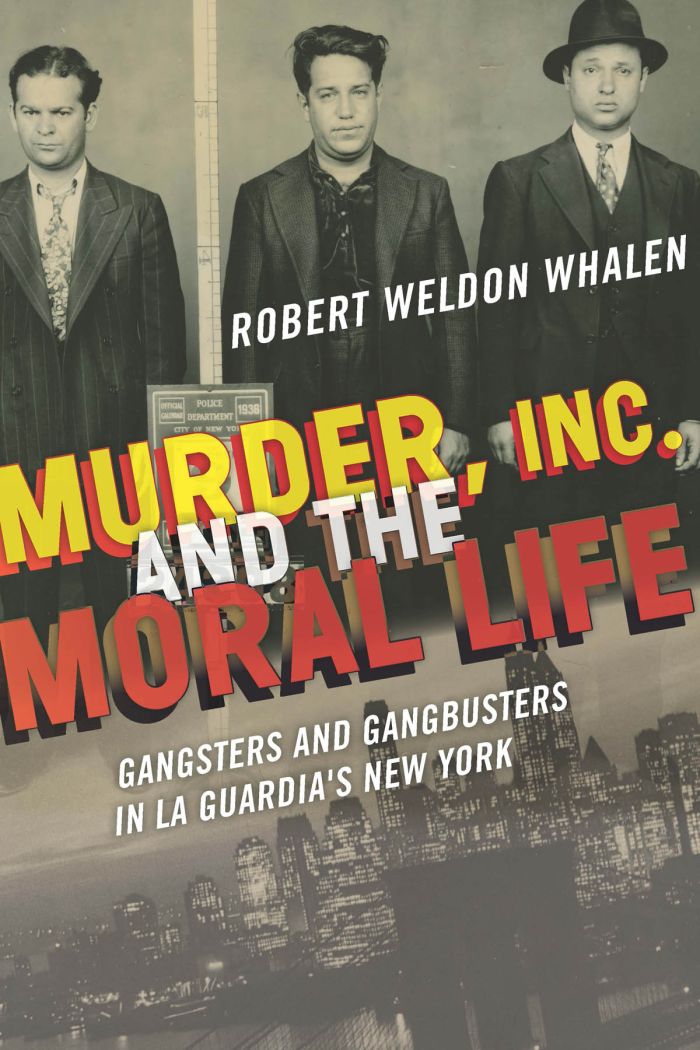Murder, Inc., and the Moral Life
Gangsters and Gangbusters in La Guardia's New York

This book can be opened with

In 1940 and 1941 a group of ruthless gangsters from Brooklyn’s Brownsville neighborhood became the focus of media frenzy when they—dubbed “Murder Inc.,” by New York World-Telegram reporter Harry Feeney—were tried for murder. It is estimated that collectively they killed hundreds of people during a reign of terror that lasted from 1931 to 1940. As the trial played out to a packed courtroom, shocked spectators gasped at the outrageous revelations made by gang leader Abe “Kid Twist” Reles and his pack of criminal accomplices.
News of the trial proliferated throughout the country; at times it received more newspaper coverage than the unabated war being waged overseas. The heinous crimes attributed to Murder, Inc., included not only murder and torture but also auto theft, burglary, assaults, robberies, fencing stolen goods, distribution of illegal drugs, and just about any “illegal activity from which a revenue could be derived.” When the trial finally came to a stunning unresolved conclusion in November 1941, newspapers generated record headlines.
Once the trial was over, tales of the Murder, Inc., gang became legendary, spawning countless books and memoirs and providing inspiration for the Hollywood gangster-movie genre. These men were fearsome brutes with an astonishing ability to wield power. People were fascinated by the “gangster” figure, which had become a symbol for moral evil and contempt and whose popularity showed no signs of abating. As both a study in criminal behavior and a cultural fascination that continues to permeate modern society, the reverberations of “Murder, Inc.” are profound, including references in contemporary mass media.
The Murder, Inc., story is as much a tale of morality as it is a gangster history, and Murder, Inc., and the Moral Life by Robert Whalen meshes both topics clearly and meticulously, relating the gangster phenomenon to modern moral theory. Each chapter covers an aspect of the Murder, Inc., case and reflects on its ethical elements and consequences. Whalen delves into the background of the criminals involved, their motives, and the violent death that surrounded them; New York City’s immigrant gang culture and its role as “Gangster City”; fiery politicians Fiorello La Guardia and Thomas E. Dewey and the choices they made to clean up the city; and the role of the gangster in popular culture and how it relates to “real life.” Whalen puts a fresh spin on the two topics, providing a vivid narrative with both historical and moral perspective.
...An ethical prism to explore the cinematic, sociological and political implications of contract killings, during an era of ethnic succession when Jewish gangs and Italian organized crime were dominant.—The New York Times
Murder, Inc., and the Moral Life: Gangsters and Gangbusters in La Guardia’s New York is a keen account of organized crime during the first half of the twentieth century. Most significant is the book’s integral, cogent analysis of the unfortunate marriage of criminality, in all of its diversity, and the general population’s fascination with it. A must-read for anyone interested in the complex story of gangsterism in the United States!—Anthony Julian Tamburri, Dean, John D. Calandra Italian American Institute
In Murder, Inc. and the Moral Life, Robert Weldon Whalen connects the real gangsters to the 'reel' gangsters and the forces that shaped and fought them. He explores our fascination with the gangster figure through the moral and ethical questions that helped to shape American culture for the past one hundred years. With sound research, good clear writing, and a critical sense of history, Whalen adds new dimensions to the study of this truly unique American archetype of crime and masculinity.—Fred Gardaphe, Distinguished Professor of English and Italian American Studies, Queens College/CUNY, From Wiseguys to Wise Men
...Whalen takes us into the lives of La Guardia, Dewey, and former Murder, Inc. boss Abe "Kid Twist" Reles, whose testimony during Dewey’s famous trials brought many of his associates to justice, but at the cost of his own life... With precision and detail, Whalen presents the series of maneuvers each side engaged in to ply their trade—the gangsters and their run of murders to support the mob’s economic interests and enforce its control on the one hand, the politicians and their efforts to bring these murderers to court and to challenge the underlying appeal of the gangster life in the general public on the other.—Italian American Review
List of Abbreviations vii
List of Illustrations ix
List of Characters xi
Prologue: Naked City 1
1 Reel Gangsters—Mobsters and the Movies 13
2 Real Gangsters: Abe Reles and the Origins of Murder, Inc. 31
3 Gangster City 54
4 Fiorello La Guardia and the Cinema of Redemption 75
5 Gangbuster: Thomas Dewey and Imperfect Justice 97
6 Murder, Inc.: “I Got Used to It” 126
7 A Theater of Ethics: Mr. Arsenic and the Murder, Inc., Trials 157
8 Ethics of Ambiguity: The Canary Could Sing but Couldn’t Fly 185
Epilogue: “That Dangerous and Sad City of the Imagination” 209
Acknowledgments 217
Notes 219
Bibliography 253
Index 259

